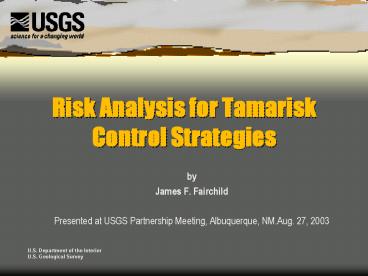Risk Analysis for Tamarisk Control Strategies - PowerPoint PPT Presentation
1 / 24
Title:
Risk Analysis for Tamarisk Control Strategies
Description:
Non-target effects of pesticides in experimental ecosystems ... 3. Shortnose sturgeon. 4. Fountain darter. 5. Greenthroat darter. 6. Bonytail chub ... – PowerPoint PPT presentation
Number of Views:21
Avg rating:3.0/5.0
Title: Risk Analysis for Tamarisk Control Strategies
1
Risk Analysis for Tamarisk Control Strategies
- by
- James F. Fairchild
- Presented at USGS Partnership Meeting,
Albuquerque, NM.Aug. 27, 2003
U.S. Department of the Interior U.S. Geological
Survey
2
Columbia Environmental Research Center
3
CERC Interest in Tamarisk Issue
- Ecological risk assessment of herbicides
- Development of analytical chemistry methods
- Environmental fate of herbicides
- Modeling, empirical assessment
- Efficacy trials with herbicides
4
Professional Background
- Research Aquatic Ecologist, 20 years
- Non-target effects of pesticides in experimental
ecosystems - Fate of pesticides (e.g. triclopyr, atrazine,
metribuzin, etc.) - Efficacy of herbicides for invasive plants
(Salvinia molesta) - Ecological risk assessment for endangered species
including fish, invertebrates, amphibians, and
plants
5
Colorado River Near Moab, Utah
Courtesy of Tom Till Gallery
6
Tamarisk Control Measures
- Mechanical removal
- Prescribed fire
- Biological controls
- Herbicide application
- Combinations of approaches
7
Mechanical Control
- Pros
- Can rapidly remove large numbers of trees
- Trees can be moved and piled for burning or other
use - Can be used to prepare site for re-vegetation
- Cons
- Extremely destructive of soils and wildlife
habitat - Dangerous for operators
- Can be expensive and logistically difficult
8
Prescribed Fire Control
- Pros
- Emulates natural processes that can benefit
native species - Removes remaining woody debris
- Facilitates subsequent re-vegetation efforts
- Cons
- Can result in property loss
- Causes short-term habitat loss
- Public and agencies may not accept as widespread
tool
9
Biological Control
- Pros
- Uses natural predator adapted to the target
species - Fewer non-target impacts on other species and
habitat - No concerns over groundwater contamination
- Cons
- Requires importation of non-native species
- Success varies depending on environmental factors
- Benefits may not be observed in acceptable time
frame
10
Chemical Control
- Pros
- Can be remotely applied
- Minimal physical disturbance
- Can be conducted with volunteer efforts with
training - Cons
- Concern over water/groundwater contamination
- Causes temporary physical impacts on habitat
- Concern over non-target chemical impacts
11
Framework for Risk Assessment
Source U.S. Environmental Protection Agency and
SETAC, 1998
Problem Formulation
Data Gathering and Analysis
Risk Characterization
Discussions Risk Assessor and Risk Manager
Risk Management
12
Chemical Risks
- Risk to applicator
- Risk for groundwater contamination (humans)
- Risk to livestock (meat/milk contamination)
- Risk to non-target endangered plants and crops
- Non-target non-target birds and mammals
- Non-target fish toxicity
13
Problem Formulation Example Risk to Endangered
Fish Species
- Use of herbicides may have non-target risks to
endangered fishes. - How sensitive are fish to the herbicide?
- Are fish likely to be exposed?
- How can risk be minimized?
14
Data gathering and analysis
- Toxicity testing for species sensitivity
- How sensitive are endangered species
- Chemical efficacy testing on tamarisk
- How much is applied?
- How is it applied?
- Chemical exposure modeling
- Where does chemical go and for how long
15
Multi-Species Sensitivity Distribution
16
Probabilistic risk assessment major risk
17
Probabilistic risk assessment minor risk
18
Herbicides Used for Tamarisk Control
19
Herbicides Used for Tamarisk Control
20
Chemical Application Methods
- Foliar spray
- Granular applications
- Stump cut and paint
- Basal bark injection
21
Efficacy and Cost/Risk Tradeoffs
22
Range of Potential Conditions
- Rangelands (livestock commercial crops)
- Alluvial plains (groundwater concerns)
- Canyon walls (limited access)
- Riparian corridors (wildlife habitat)
- Refuge wetlands (endangered species)
- Military sites (unexploded ordinants)
23
Exposure/Risk Minimization
- Conduct appropriate risk analysis
- Use of efficacious chemical
- Use of efficacious dose
- Optimization of chemical application procedures
- Amount applied
- How applied
- When applied
24
Conclusions
- Tamarisk is enormous problem
- Multiple control approaches needed
- Each control method has risks and benefits
- Risks can be evaluated and minimized in a
science-based framework - Successful tamarisk removal program will involve
science and the public in a partnership































